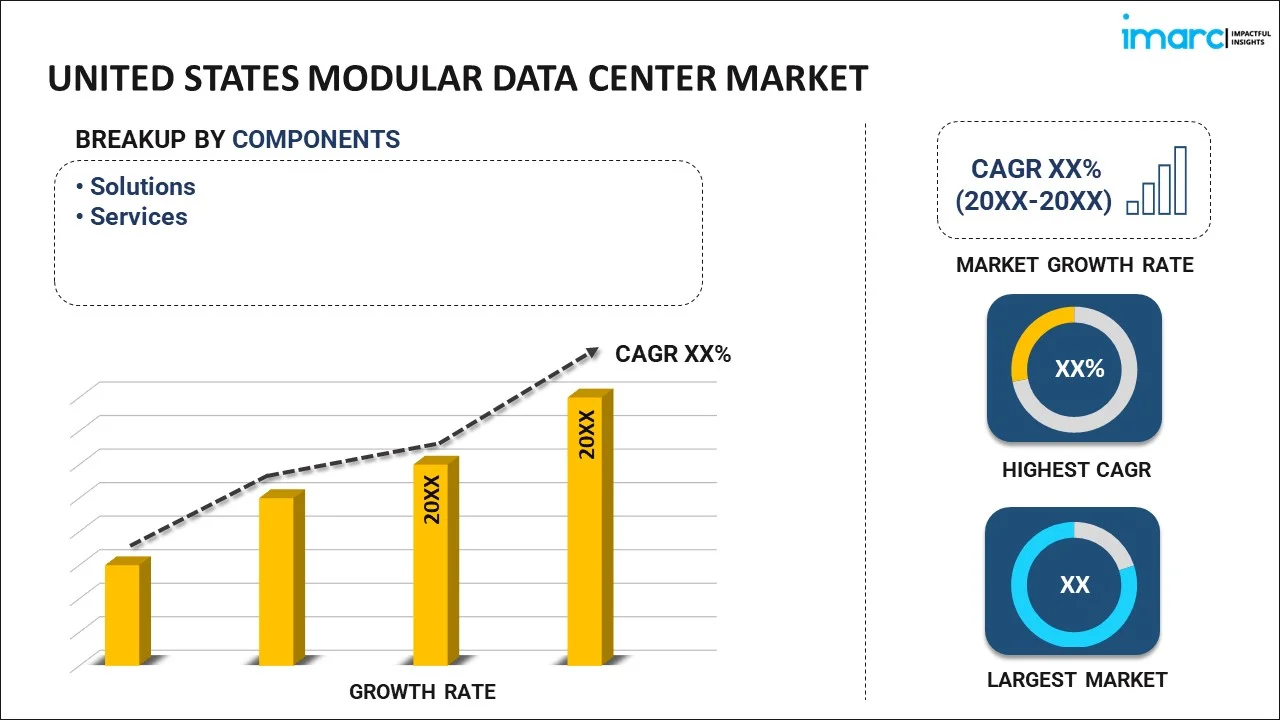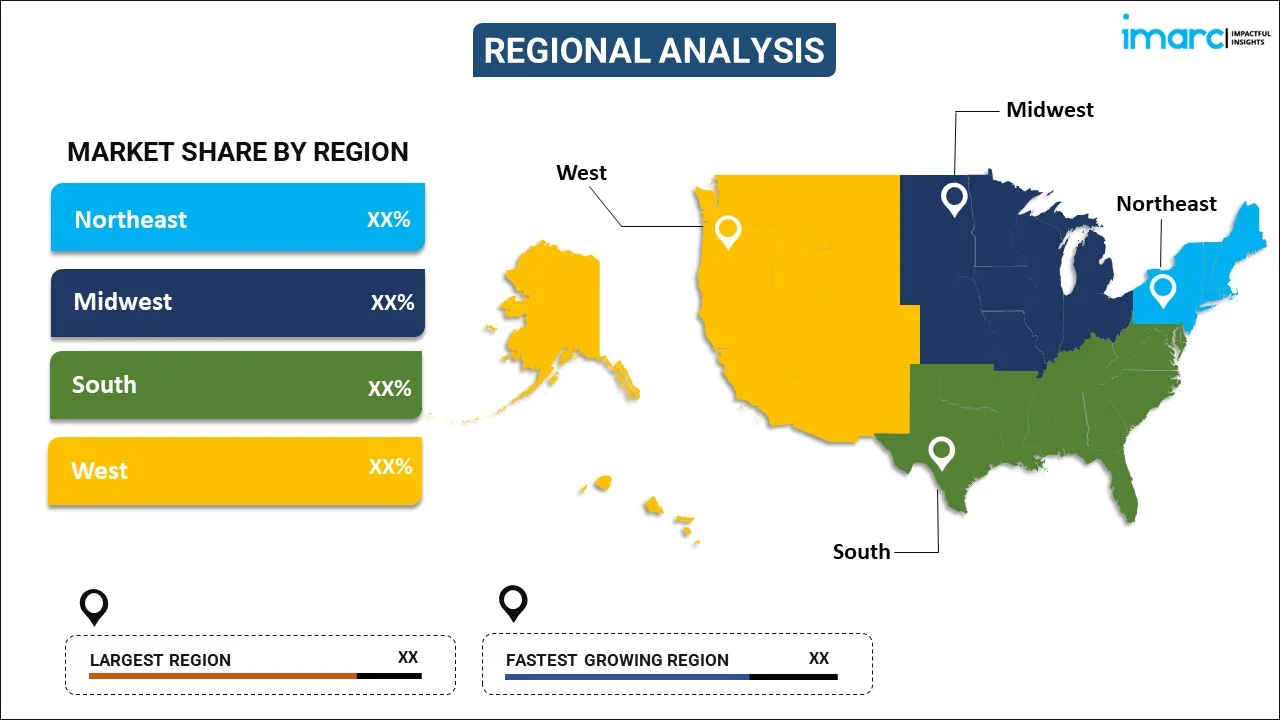
United States Modular Data Center Market Report by Component (Solutions, Services), Data Center Size (Small and Medium-sized Data Centers, Large Data Centers), Application (Disaster Backup, High Performance/ Edge Computing, Data Center Expansion, Starter Data Centers), Industry Vertical (BFSI, IT and Telecom, Retail and Manufacturing, Healthcare, Energy, Media and Entertainment, Government and Defense, and Others), and Region 2024-2032
Market Overview:
United States modular data center market size is projected to exhibit a growth rate (CAGR) of 16.11% during 2024-2032. The rising demand for scalable data storage solutions, the need for quick deployment to support emerging technologies, surging energy efficiency considerations, the decentralization of data processing, the adoption of cloud computing, cost, and increased competition among key players are some of the primary factors propelling the market growth.
|
Report Attribute
|
Key Statistics
|
|---|---|
|
Base Year
|
2023 |
|
Forecast Years
|
2024-2032
|
|
Historical Years
|
2018-2023
|
| Market Growth Rate (2024-2032) | 16.11% |
A modular data center is a scalable and self-contained facility that houses data processing, storage, and networking equipment within prefabricated, standardized modules. They are designed to be easily transported, deployed, and expanded as needed, making them a flexible solution for various industries. Modular data centers work by integrating all the essential components of a traditional data center into compact units, including power and cooling systems, security measures, and IT infrastructure. They are typically built off-site and then assembled at the desired location, significantly reducing construction time and costs. The primary uses of modular data centers encompass a wide range of applications. They are often employed by organizations that require rapid deployment of IT infrastructure, such as disaster recovery centers, remote or temporary operations, and edge computing facilities. Their modular nature also makes them suitable for companies with fluctuating computing demands, as additional modules can be easily added or removed to match evolving requirements. The advantages of modular data centers include enhanced scalability, energy efficiency, and cost savings. Moreover, modular data centers are designed with energy-efficient technologies and cooling systems, optimizing energy consumption.
United States Modular Data Center Market Trends:
The United States modular data center market is influenced by several key drivers, such as the escalating demand for scalable and efficient data storage solutions and the burgeoning volume of digital information. Additionally, the need for rapid deployment of data centers to support emerging technologies, such as fifth-generation (5G), edge computing, and the Internet of Things (IoT) applications, has further fueled the market growth. In line with this, businesses are turning to modular data centers that are designed for optimal energy consumption and are equipped with advanced cooling systems, which is boosting the market growth. Moreover, the ongoing trend towards remote work and the decentralization of data processing has prompted organizations to invest in modular data centers that can be strategically placed closer to end-users, enhancing latency-sensitive applications, which is supporting the market growth. Apart from this, the increasing adoption of cloud computing and the consequent need for hybrid and edge data centers are among the key drivers, as they require flexible and scalable infrastructure solutions, is propelling the facility demand.
United States Modular Data Center Market Segmentation:
IMARC Group provides an analysis of the key trends in each segment of the market, along with forecasts at the country level for 2024-2032. Our report has categorized the market based on component, data center size, application, and industry vertical.
Component Insights:

- Solutions
- All-in-One Module
- Individual Module
- Services
- Design and Consulting
- Integration and Deployment
- Support and Maintenance
The report has provided a detailed breakup and analysis of the market based on the component. This includes solutions (all-in-one module and individual module) and services (design and consulting, integration and deployment, and support and maintenance).
Data Center Size Insights:
- Small and Medium-sized Data Centers
- Large Data Centers
A detailed breakup and analysis of the market based on data center size have also been provided in the report. This includes small and medium-sized data centers and large data centers.
Application Insights:
- Disaster Backup
- High Performance/ Edge Computing
- Data Center Expansion
- Starter Data Centers
The report has provided a detailed breakup and analysis of the market based on the application. This includes disaster backup, high performance/ edge computing, data center expansion, and starter data centers.
Industry Vertical Insights:
- BFSI
- IT and Telecom
- Retail and Manufacturing
- Healthcare
- Energy
- Media and Entertainment
- Government and Defense
- Others
A detailed breakup and analysis of the market based on industry vertical have also been provided in the report. This includes BFSI, IT and telecom, retail and manufacturing, healthcare, energy, media and entertainment, government and defense, and others.
Regional Insights:

- Northeast
- Midwest
- South
- West
The report has also provided a comprehensive analysis of all the major regional markets, which include the Northeast, Midwest, South, and West.
Competitive Landscape:
The market research report has also provided a comprehensive analysis of the competitive landscape in the market. Competitive analysis such as market structure, key player positioning, top winning strategies, competitive dashboard, and company evaluation quadrant has been covered in the report. Also, detailed profiles of all major companies have been provided. Some of the key players include:
- BASELAYER Technology LLC
- Dell Technologies Inc.
- Hewlett Packard Enterprise Development LP
- Eaton Corporation plc
- Rittal GmbH & Co. KG
(Please note that this is only a partial list of the key players, and the complete list is provided in the report.)
United States Modular Data Center Market Report Coverage:
| Report Features | Details |
|---|---|
| Base Year of the Analysis | 2023 |
| Historical Period | 2018-2023 |
| Forecast Period | 2024-2032 |
| Units | US$ Million |
| Scope of the Report | Exploration of Historical Trends and Market Outlook, Industry Catalysts and Challenges, Segment-Wise Historical and Future Market Assessment:
|
| Components Covered |
|
| Data Center Sizes Covered | Small and Medium-sized Data Centers, Large Data Centers |
| Applications Covered | Disaster Backup, High Performance/ Edge Computing, Data Center Expansion, Starter Data Centers |
| Industry Verticals Covered | BFSI, IT and Telecom, Retail and Manufacturing, Healthcare, Energy, Media and Entertainment, Government and Defense, Others |
| Regions Covered | Northeast, Midwest, South, West |
| Companies Covered | BASELAYER Technology LLC, Dell Technologies Inc., Hewlett Packard Enterprise Development LP, Eaton Corporation plc, Rittal GmbH & Co. KG, etc. (Please note that this is only a partial list of the key players, and the complete list is provided in the report.) |
| Customization Scope | 10% Free Customization |
| Report Price and Purchase Option | Single User License: US$ 3699 Five User License: US$ 4699 Corporate License: US$ 5699 |
| Post-Sale Analyst Support | 10-12 Weeks |
| Delivery Format | PDF and Excel through Email (We can also provide the editable version of the report in PPT/Word format on special request) |
Key Questions Answered in This Report:
- How has the United States modular data center market performed so far and how will it perform in the coming years?
- What has been the impact of COVID-19 on the United States modular data center market?
- What is the breakup of the United States modular data center market on the basis of component?
- What is the breakup of the United States modular data center market on the basis of data center size?
- What is the breakup of the United States modular data center market on the basis of application?
- What is the breakup of the United States modular data center market on the basis of industry vertical?
- What are the various stages in the value chain of the United States modular data center market?
- What are the key driving factors and challenges in the United States modular data center?
- What is the structure of the United States modular data center market and who are the key players?
- What is the degree of competition in the United States modular data center market?
Key Benefits for Stakeholders:
- IMARC’s industry report offers a comprehensive quantitative analysis of various market segments, historical and current market trends, market forecasts, and dynamics of the United States modular data center market from 2018-2032.
- The research report provides the latest information on the market drivers, challenges, and opportunities in the United States modular data center market.
- Porter's five forces analysis assist stakeholders in assessing the impact of new entrants, competitive rivalry, supplier power, buyer power, and the threat of substitution. It helps stakeholders to analyze the level of competition within the United States modular data center industry and its attractiveness.
- A competitive landscape allows stakeholders to understand their competitive environment and provides an insight into the current positions of key players in the market.
Need more help?
- Speak to our experienced analysts for insights on the current market scenarios.
- Include additional segments and countries to customize the report as per your requirement.
- Gain an unparalleled competitive advantage in your domain by understanding how to utilize the report and positively impacting your operations and revenue.
- For further assistance, please connect with our analysts.
 Inquire Before Buying
Inquire Before Buying
 Speak to an Analyst
Speak to an Analyst
 Request Brochure
Request Brochure
 Request Customization
Request Customization




.webp)




.webp)












